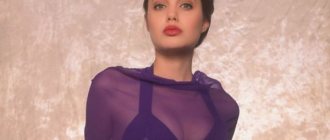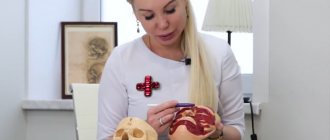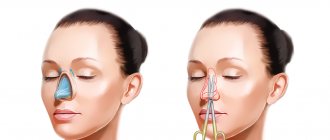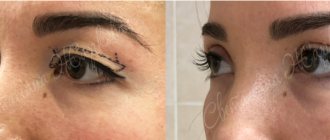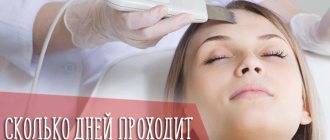Rhinoplasty is a surgical intervention aimed at correcting the appearance of the nose, as well as eliminating discomfort due to difficulty in nasal breathing. It is carried out for aesthetic reasons when the patient is not satisfied with the shape of his own nose, and for medical reasons - for a deviated nasal septum or nasal fractures.
Rhinoplasty is one of the most popular plastic surgeries. However, it is also one of the most difficult due to the structural features of the nose, the difficulty of surgical access, and the limited area of the operation. Of course, the experience and qualifications of the operating surgeon are very important, but successful recovery and satisfaction with the result largely depend on the patient’s compliance with the recommendations during the rehabilitation period.
Stages of recovery after rhinoplasty
Rhinoplasty requires a long rehabilitation period. In most cases, it takes at least 6 months, sometimes this period extends to a year. The patient will be able to return to normal life with some restrictions approximately a month after the operation, but the final results will not be visible soon.
Immediately after surgery
The operation lasts 2-3 hours and is most often performed under general anesthesia. After the patient comes to his senses, he will be able to eat and perform hygiene procedures. Nasal tamponade is not always performed. Nasal breathing can be slightly hampered by splints in the nasal cavity, which maintain its shape and stop bleeding. A plaster splint is placed on top of the nose. It is possible, but not necessary, for hematomas to appear in the nose area and around the eyes. The patient spends 1 to 3 days in the hospital.
First early stage
Primary recovery after rhinoplasty lasts up to 7 days. During this period, swelling is most pronounced, which can spread to the cheeks and lower part of the face. During the week, it is recommended to maintain maximum rest and avoid physical activity. The patient must take medications prescribed by the doctor, treat postoperative sutures, and rinse the nasal cavity to prevent the formation of mucus and crusts.
Second early stage
Lasts from 7 to 14 days. Most often, a week after the operation, a follow-up examination is scheduled, during which the patient will have the plaster cast and splints removed, and the sutures will be removed. The doctor will assess the condition of the nose and give recommendations for further rehabilitation. During this period, severe swelling of the face subsides, bruises, if any, disappear. Swelling may persist on the back of the nose, tip, and lateral surfaces. In general, health improves and the patient can return to normal life.
Third stage
The period is from 2 weeks to 1 month after surgery. The shape of the nose is gradually improving (however, it is still far from ideal), all signs of surgical intervention disappear on the face, the seams fade and become less noticeable. During this period, physiotherapeutic procedures are recommended so that new structures in the nose are formed strong and resistant to external influences.
Between the third stage and the late recovery period, a gradual process of scarring occurs. External changes at this time are hardly noticeable.
Late recovery stage
In the period from 6 months to 1 year, the nose acquires the ideal shape for which the operation was performed. The scars become almost invisible. The patient completely returns to the usual rhythm of life, stress, and all restrictions are removed after rhinoplasty. You can perform cosmetic procedures in the nose area.
Personal hygiene and nasal care
In the first days after rhinoplasty, you should not touch your nose, touch the stitches, change tampons without permission, or wet the plaster retainer. For three days, washing your hair and brushing your teeth is canceled. Subsequently, hygiene procedures are carried out very carefully. Using cosmetics for two weeks is not advisable. A doctor must give permission for this.
To cleanse the nasal mucosa from blood clots, secretions and mucus, soft turundas or cotton wool sticks are used. It is prohibited to blow your nose, as the pressure of the air stream easily deforms cartilage and bone structures.
The doctor will prescribe anti-inflammatory, antibacterial and wound-healing agents in the form of an ointment or gel, which should be used to treat the nasal mucous membranes daily. From a certain time, you can do daily rinsing of the nasal passages, acting very carefully and carefully.
The surgeon must say whether vasoconstrictor sprays or drops can be used. In some cases this is extremely undesirable, in others it is acceptable - rarely and in a minimal dosage. Violating recommendations and independently replacing some drugs with others is dangerous to health and can lead to dire consequences in terms of the outcome of the operation.
Nutrition after rhinoplasty
After plastic surgery on the nose, you should adhere to some dietary restrictions. An important condition for rapid healing is facial rest, so you need to minimize the work of the masticatory muscles. In the first 1-2 weeks after surgery, preference should be given to liquid and semi-liquid foods, which should not be hot. You cannot drink hot tea, coffee, or too cold drinks. It is necessary to reduce the consumption of salt, smoked foods, hot and spicy foods, which retain water in the body and contribute to the appearance of edema.
Crooked nose after septoplasty
A crooked nose is not always just an aesthetic problem, it is also a matter of well-being and health. A deviated nasal septum leads to poor breathing . The internal organs do not receive enough oxygen, gas exchange in the tissues is disrupted, the person sleeps poorly, snores, and breathing may stop during sleep. Therefore, plastic surgeons suggest correcting this with a special operation to mechanically straighten the nasal septum. It does not require general anesthesia, after septoplasty there is no long recovery period required, and it is not accompanied by large-scale blood loss. However, if the operation is performed poorly or the doctor’s recommendations are not followed, complications after septoplasty are possible. These include a crooked nose. First of all, you need to make sure that this is not a normal consequence of the postoperative period, but a defect after septoplasty that needs to be corrected. After a six-month period, the nasal septum can be corrected, which will correct previous errors.
Useful materials:
Humped nose Deviated nasal septum
Recommendations for successful recovery
What to do after rhinoplasty:
- follow all doctor’s advice and prescriptions;
- sleep on your back with the head of the bed raised or on a high pillow;
- exclude significant physical activity for 2-3 months;
- follow a diet;
- do not use active facial expressions;
- sneeze with your mouth closed.
What not to do during the rehabilitation period:
- To wear glasses;
- sleep on your side, stomach;
- lift weights;
- play sports with significant loads;
- blow your nose with force;
- take a hot bath, visit a bathhouse, sauna, solarium.
Working with gait
Along with the listed exercises, you need to add a complex for quick gait restoration and rehabilitation. Here are some effective options:
- Use your toes to grab and hold a small object;
- Roll a ball with the foot of the sore limb;
- Standing on your toes, on your heels;
- Walking sideways and backwards.
If possible, you can exercise on exercise bikes. The listed exercises and prescribed treatment after an injury cannot be neglected. Physical education during rehabilitation quickly restores and heals the body from the day the cast is removed.
Recovery after a fracture should continue until the body is completely restored. You can stop exercising after you have regained mobility, swelling has subsided, and there is no pain. The success of rehabilitation depends not only on the will of the patient and the treatment program.
Rhinoplasty of the nose in Moscow. Prices for nose surgery
The cost of nose surgery in Moscow depends on many factors. In the table we provide some approximate prices, but the surgeon will be able to name the final cost of nose surgery only after consultation, because Each case is individual and the solution to similar problems can differ radically from person to person. Check out the estimated prices and send your photos to the doctor for a preliminary consultation.
| Rhinoplasty prices (RUB) | |
| Plastic surgery of the cartilaginous part of the nose (tip of the nose) - 80,000 rubles Plastic surgery of the bony part of the nose (dorsum of the nose) - 85,000 rubles Full rhinoseptoplasty - 165,000 rubles Harvesting of ear cartilage for contour plastic surgery of the nose - 15,000 rubles Revision rhinoplasty (secondary) - 180,000 rubles | |
A more detailed price list for plastic surgery can be found here
Reviews of rhinoplasty with Galina Khrushch in Moscow
I still have a cast on my nose and rehabilitation is in full swing. But I already want to say thank you to Galina Viktorovna. She has a light hand, so I don’t experience any discomfort. Everything is fine. Many people at work know that I had my nose done. And many are already planning to change something in themselves, looking at me. I'm happy with it. It's so nice when people compliment you. Their number will increase 10 times as soon as I remove the cast and as soon as all the swelling goes down. Thank you, Galina Viktorovna. I am pleased!
Ksenia Karpenko
I had rhinoplasty done by Galina. Immediately after the plaster, the nose seemed large due to swelling, but even then it was already clear that the shape had become more aesthetic. Now all the tissues have healed and you can see that the nose is cute. The doctor removed the hump and corrected the drooping tip of the nose. The result is a slight, subtle snub nose that suits my face very well. I can only say good things about Galina. I have never met such an attentive doctor. Very caring attitude towards patients, including in the postoperative period.
Nara
What is rhinoplasty and what problems does it solve?
| Rhinoplasty is a nose job. With the help of rhinoplasty, you can not only change the size and shape of the nose, improve breathing, but also harmonize the proportions of the face, make it more feminine, achieve the effect of visual enlargement of the eyes, and create an additional emphasis on the lips. Removing a hump in the nose, adjusting its length, or correcting a wide nasal tip are the most popular problems that rhinoplasty solves. |
Beauty is often difficult to define objectively.
This can be a combination of factors such as symmetry, aesthetically pleasing proportions and relationships. In the modern world, in conditions of tough professional and social competition, the importance of the appearance factor has become extremely important. The nose, as the most prominent part of the face, plays an important aesthetic role. Its shape largely determines the individuality and attractiveness of a person.
The presence of asymmetry, disproportion and incorrect relationships of the nose are a common cause of dissatisfaction with one's appearance.
But no need to worry!
The development of plastic surgery has made it possible to adjust the shape of the nose, which can make your appearance more impressive and harmonious, and you more successful.
Indications for nose surgery
If we look at the indications for rhinoplasty surgery a little deeper, they can be divided into two types: medical indications and aesthetic indications.
Medical indications
- Deformation of bone or cartilage tissue as a result of an accident or injury
- Congenital or acquired changes in the nose area
- Deviated nasal septum, difficulty breathing, snoring, etc.
In these cases, you will need an operation - rhinoseptoplasty, the task of which is to correct the nasal septum. Rhinoseptoplasty is often combined with correction of the appearance of the nose.
Aesthetic indications
- Wide wings of the nose or dorsum
- Presence of a hump
- The tip of the nose is turned up or, conversely, too drooping
- No visible bridge of the nose
- Large or too thin nose tip
Unlike medical indications, aesthetic indications are not mandatory, since they do not harm human health, but at the same time they can cause psychological harm. The decision to perform or not to perform surgery for aesthetic deformities of the nose is made by the patient himself. But in the case of medical indications, it is worth thinking more seriously about rhinoplasty, since we are talking about health.
You can read about possible motivating factors for rhinoplasty in my article “What pushes people to undergo rhinoplasty?”
Who can get a nose job in Moscow?
If you are looking for a good plastic surgeon for rhinoplasty in Moscow, then I recommend that you pay special attention to several main, in my opinion, factors:
- carefully review the plastic surgeon's portfolio. Having photos before and after rhinoplasty is the best recommendation.
- look for reviews of the plastic surgeon
- personal contact - consult with several plastic surgeons to choose one whom you can trust unconditionally.
